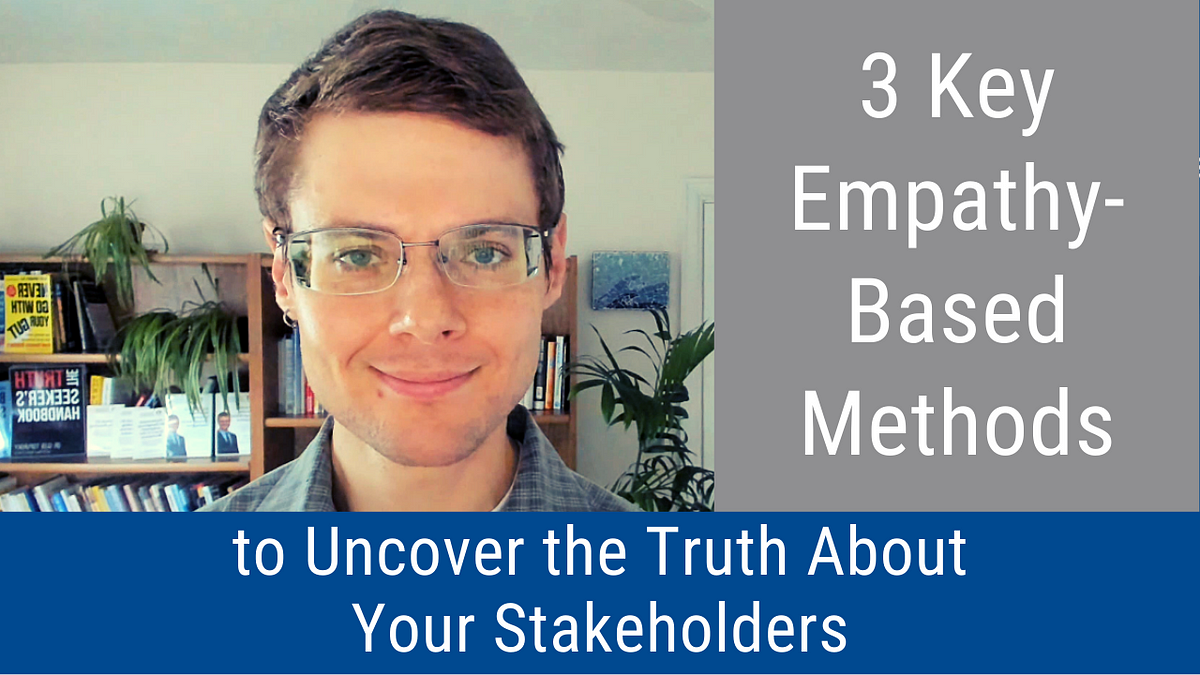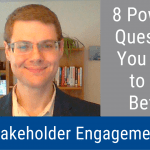
Using the three social intelligence methods during a stakeholder meeting will help you learn the truth about your stakeholders’ needs, which will empower you to solve their problems and foster stronger relationships with them. That’s the key take-away message of this episode of the Wise Decision Maker Show, which describes the 3 key empathy-based methods to uncover the truth about your stakeholders.
Video: “3 Key Empathy-Based Methods to Uncover the Truth About Your Stakeholders”
Podcast: “3 Key Empathy-Based Methods to Uncover the Truth About Your Stakeholders”
Links Mentioned in Videocast and Podcast
- Here’s the article on the 3 Key Empathy-Based Methods to Uncover the Truth About Your Stakeholders
- The book Never Go With Your Gut: How Pioneering Leaders Make the Best Decisions and Avoid Business Disasters is available here
- You are welcome to register for the free Wise Decision Maker Course
Transcript
Hello, everyone, and welcome to another episode of the Wise Decision Maker Show where we help you make the wisest and most profitable decisions. Today, I want to talk about the three key empathy based methods to uncover the truth about your stakeholders. Everyone has a set of important stakeholders that they are influenced by. So these are folks who you want to influence yourself who you’re influenced by. And you want to uncover the truth, the facts about them. Now, it’s often difficult to do so because people might not want you to know and understand their motivations. Or they might not realize that you don’t understand all of their motivations. So it’s kind of hard to come up to someone and say, Hey, Bob, can you tell me all your motivations? What’s driving you? How are you feeling, really feeling about our relationship, about what I’m the product that I’m trying to sell you, or the business deal that we’re trying to do? Because people don’t necessarily want to tell you that and because it feels awkward. And it’s not really the way that you engage socially politely, at least in our society, with other people with how you communicate and how you elaborate your relationships. Maybe therapists can tell us that, hey, this is how you should do it. Ideally, in an ideal world, but we’re not a met world. So you want to figure out effective methods to uncover the truth, the facts about your stakeholders, their feelings, their thoughts. And if you’ve been watching this show, for a while, you’ve been checking it out for a while following us for a while, you know that feelings determine our decisions, our thoughts, our behaviors, much more than logic and reason does. But at least 90% of what we do is driven by what we feel. So you want to figure out what other people feel, especially as it’s really important. So feelings, remember, are really important, and we don’t pay nearly enough attention to them. In order to figure out how to uncover the truth about your stakeholders, you need to use the techniques of social intelligence, social intelligence, that’s going to be the key social intelligence is the strategic capacity to evaluate and influence other people’s emotions and relationships. That’s what it’s about. So it’s a type of intelligence. It’s, of course, intelligence is the ability to solve problems, and achieve your goals in a wide variety of ways, using your mind using various aspects of your mental processes. social intelligence refers specifically to doing that in social settings. So you want to evaluate other people and influence them, specifically, their emotions. Because those are what drive behavior and thought patterns and their relationships with you and with other people. So in order to do so, then what you need to do is build trust. That’s a fundamental skill, capacity of social intelligence. You need to be able to use the tools of social intelligence to solve problems, solve issues, people related issues, and also strengthen your relationships. That’s a fundamental aspect of social intelligence. How do you strengthen your relationships, and those are all things that are really important to do with your key stakeholders. If you want to achieve your goals, whatever your goals are, with your key stakeholders, now talk about three steps for doing so. Three social intelligence based methods that are three steps following each other. And there are three methods that will help you achieve all of those goals with your key stakeholders, empathetic listening, the first step, the first method, echoing and mirroring, as after you’ve listened in the process of listening, and then curious questioning to get some elaboration and clarification on what your Keystone coders are sharing. First, empathetic listening, that is the first step you really want to hear them. And empathy, of course, refers to the ability of undergraduates to understand what other people feel. So the skill set, and there are a number of important components, sub skills within the skill set within this ability of really understanding and grasping what other people feel. So empathetic listening. As you do that, that is a fundamental aspect of understanding what other people feel. So you want to focus on as you’re listening to your key stakeholders, of course, the content, so the content of whatever they’re saying, the specific messages that they’re trying to sell and you definitely more than a rational, logical things, but you also want to be focusing on what they might not be telling you but what they shouldn’t be telling you. So something that might be Missing, that you think should be there. Those are also things that you want to focus on as you’re appreciating the content. But just as important as the content will be the way they say it’s the tone, the body, the tone, how they say it. So their tonality, if I say, I think Michael should take that project, versus I think Michael should take that project. Those are two different things. Those mean two different things, two very different things. But if I write it out, just if you look at the content, they mean exactly the same thing. tonality conveys really important meanings and shades of emotional expression, emotions drive our behaviors, thoughts, experiences, decisions. So you want to understand the tone that shapes the content. And of course, the body language. Are they as they’re saying, smiling? Are they founding? Do they? Are they crossing their arms? Are they winking? There are various body languages, and those are just the most expressive ones leaning forward? Are they leaning backward? What are they doing? How are they saying it, so not simply the tone, but also what does their body convey? If their content is at odds with their body language, then you should suspect something, there’s extensive research showing that it’s very hard for people to control the content, the tone, and the body language, if those if what the content of what they’re saying is at odds with what they’re really feeling. And what they’re really thinking is that if there’s some internal conflicts going there, or if they’re knowingly misleading, or unknowingly misleading, because people often don’t know their own minds, their own feelings, especially they think they do, but they often don’t seem gotta be paying attention to all of these things, in order to understand not simply their thought patterns, but what’s lying underneath that their feelings, their emotions, maybe things are trying to hide from you, maybe things that aren’t realizing themselves. And you got to be signaling that you’re paying attention through focusing on all of these things, your key stakeholders want to know that you’re actually paying attention to them. So through empathetic listening, focusing your full attention on them 100% of your attention on their content of what they’re saying, the tone with which they’re using, and their body language, will help signal that you’re actually paying attention to them. And of course, a very effective technique of paying attention to them and signaling that you’re paying attention to them is echoing, echoing whatever they’re telling you. So echoing and then mirroring, so echoing and mirroring is a transition from empathetic listening, you should be doing this intermittently throughout your active listening, as the other person finishes making a point. So it should be done every minute or two, depending on how long winded they are. Maybe three minutes if they’re really long winded. So I got to rephrase what you hear. So something like Oh, hey, Mary. So what I heard you say was this. And smile and nod. Just briefly rephrase whatever Mary is saying. It is done subtly, so that Mary feels like you’re actively listening and that you’re checking for understanding, using their jargon. So if Mary uses an acronym, use the same acronym repeated, if she uses certain terminology that’s not commonly used. Use that, if she’ll use a colloquial expression, try to weave that in whatever jargon they’re using. You want to use that jargon that makes them feel that you’re part of the group. So using their jargon, of course, you want to make sure that you understand the jargon and they’re using. So that might be part you might ask for clarification, the first time you’re hearing it, if you think you can’t, if it’s important to look for clarification, if you can’t figure it out on your own, but you want to play cool, sometimes you might want to just look it up later, whatever jargon they’re using, especially if it’s in an asynchronous communication, like email, text, voicemail, and mirror their tone and posture. So don’t simply echo what they’re saying. But try to mirror how they’re behaving. Don’t exactly mirror them. So don’t look exactly like they do at the moment they do it. But wait for a couple of seconds. You know, if they lean closer to you, then in a couple of seconds, lean closer to them. If they lean back, maybe in a couple of seconds, lean back, if they put their hand to their chin and go at some point in the conversation, not immediately, of course but when it’s up appropriate for the same thing. Hmm. So this mirroring and posturing puts you in sync with each other, puts you in flow, and it helps the other person feel that you’re connecting, and that you are understanding what they’re really trying to convey. And then for clarification, what they do when you aren’t sure about something, or you want to address a point of understanding of maybe contention, maybe disagreement, maybe, um, clarity, maybe confusion, you want to express curiosity. So use curious questioning, not in a probing or provocative way. But in a curious way, you want to find out your friends, they are curious about them. People like to talk about themselves. So make sure to focus on them. Make sure to not focus on yourself, use the eye language, not say, Oh, I’m curious to learn about why you feel that way, Michael? So talk about asking Michael about why he feels that way, say, Hey, can you please share about Michael about this, I’m really curious to learn more, that is a good way of approaching this, then you might envision what they might want to hear you asking them sometimes people will leave off a point. But they aren’t really willing to talk about a point. So that’s something you want to notice is notice what’s not there and notice something that they might want to talk about something that feels like it should be talked about. But that’s not an ultimate table, use curiosity to ask that sometimes it might help to just repeat the same last couple of words, they said, in a curious manner. So if they’re talking about, you know, let’s say how their sales are going down. And that’s the last thing that they said, and say something like going down. And that will encourage them to elaborate on this topic, strong curiosity and non threatening way you’re echoing immediately. It’s kind of a combination of echoing and mirroring and curious questions. So it’s showing you’re paying attention, you’re curious, you want to know more, and that it elaborates on this topic, then something to remember, and something to be careful about is considered asking the question indirectly, especially if you’re noticing an area of disagreement or contention. So for example, if they’re describing a meeting that they had with someone, and you think that that someone knew about the topic, is not going to agree with them that the meeting was more contentious than they might want to acknowledge. You might ask something like, oh, instead of saying something like, well of Susan, I’m pretty sure Ella would have disagreed with that. Can you please explain what happened because it doesn’t sound like she was disagreeing with that. That’s kind of coming off a little bit aggressive. You don’t want to do that with your key stakeholders, you might say something like that anything about Ella’s reaction surprise you or that elos reaction goes You’re expected. Something like that. That’s an indirect method of asking about the same thing. And it will get them to talk about it, because they will talk about the reaction surprise, and of course, then you can follow up with other curious questions. And that is a way of expressing curiosity without coming off as too aggressive to probing. So that’s a good technique to use. So these are the three social intelligence methods that I want to share about, and if you use them, I’m very confident that you’ll be able to greatly improve your ability to engage effectively with your key stakeholders by uncovering the truth about what they do and what they think. All right. This has been another episode of the wise decision maker show. And there’s a blog in the notes as usual, that will help you see a case study of how this is pragmatically applied in professional settings that I think will be quite helpful to you. If you want to know the details and the in depth richness of how to apply this in professional settings. So check out that blog in the show notes. Also, check out the books on these topics that are linked in the show notes. The blind spots between us are how to overcome unconscious cognitive bias and build better relationships, talk about effective communication and relationship building social intelligence skills, and then never go with your gut. How pioneering leaders make the best decisions and avoid business disasters talks about effective decision making, risk management and strategic planning that relate Of course, to important stakeholders. So now, the other two books linked in the show notes make sure to check those out. If you liked this episode, please click like and Subscribe to our podcast or podcast, we convey this information both in the video and podcast form. So whatever whichever way you prefer to consume your content videos or podcasts, please subscribe to the channel. And please leave your comments on whatever you heard. So make sure to leave your comments I love to hear from you. Now, you can also follow us on social media, send us messages and we share a lot of useful articles and topics like this. Useful articles, useful videos, useful podcasts, memes, you name it, we got it. So please share that. Check that out. I want you to encourage you to sign up for the wise decision maker guide at disasteravoidanceexperts.com/subscribe. The course provides this sort of content, the articles, videos, podcasts and sends them out to you conveniently into your email inbox. So I hope you sign up for that. And of course follow us on social media as I mentioned. Alright, that’s all I wanted to share with you. And I hope that as always, this episode of the wise decision maker show helps you make the wisest and most profitable decisions
Transcribed by https://otter.ai
Originally Published at Disaster Avoidance Experts
Bio: An internationally-recognized thought leader known as the Disaster Avoidance Expert, Dr. Gleb Tsipursky is on a mission to protect leaders from dangerous judgment errors known as cognitive biases by developing the most effective decision-making strategies. A best-selling author, he is best known for Never Go With Your Gut: How Pioneering Leaders Make the Best Decisions and Avoid Business Disasters (Career Press, 2019), The Blindspots Between Us: How to Overcome Unconscious Cognitive Bias and Build Better Relationships (New Harbinger, 2020), and Resilience: Adapt and Plan for the New Abnormal of the COVID-19 Coronavirus Pandemic (Changemakers Books, 2020). He published over 550 articles and gave more than 450 interviews to prominent venues such as Inc. Magazine, Entrepreneur, CBS News, Time, Business Insider, Government Executive, The Chronicle of Philanthropy, Fast Company, and elsewhere. His expertise comes from over 20 years of consulting, coaching, and speaking and training as the CEO of Disaster Avoidance Experts. It also stems from over 15 years in academia as a behavioral economist and cognitive neuroscientist. Contact him at Gleb[at]DisasterAvoidanceExperts[dot]com, Twitter @gleb_tsipursky, Instagram @dr_gleb_tsipursky, LinkedIn, and register for his free Wise Decision Maker Course.


















